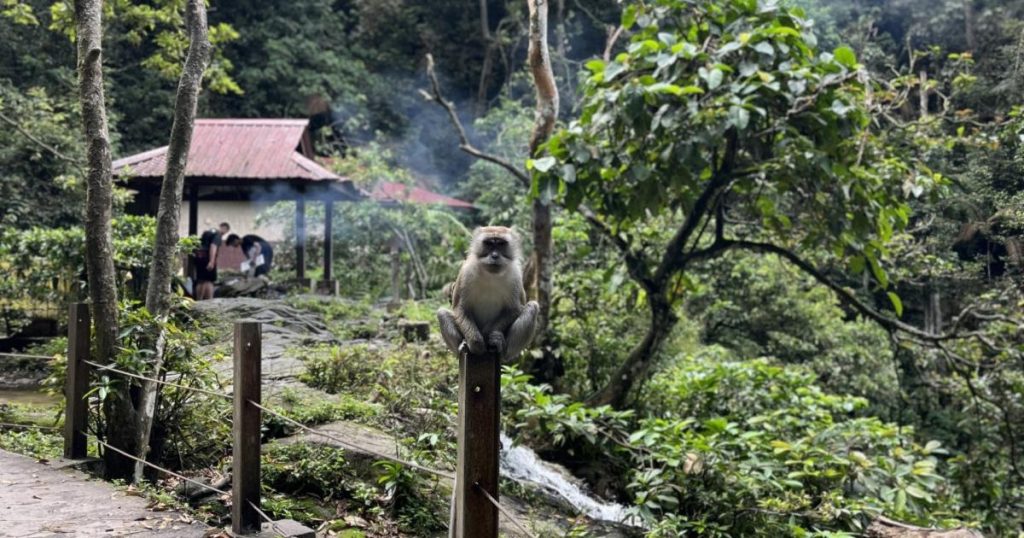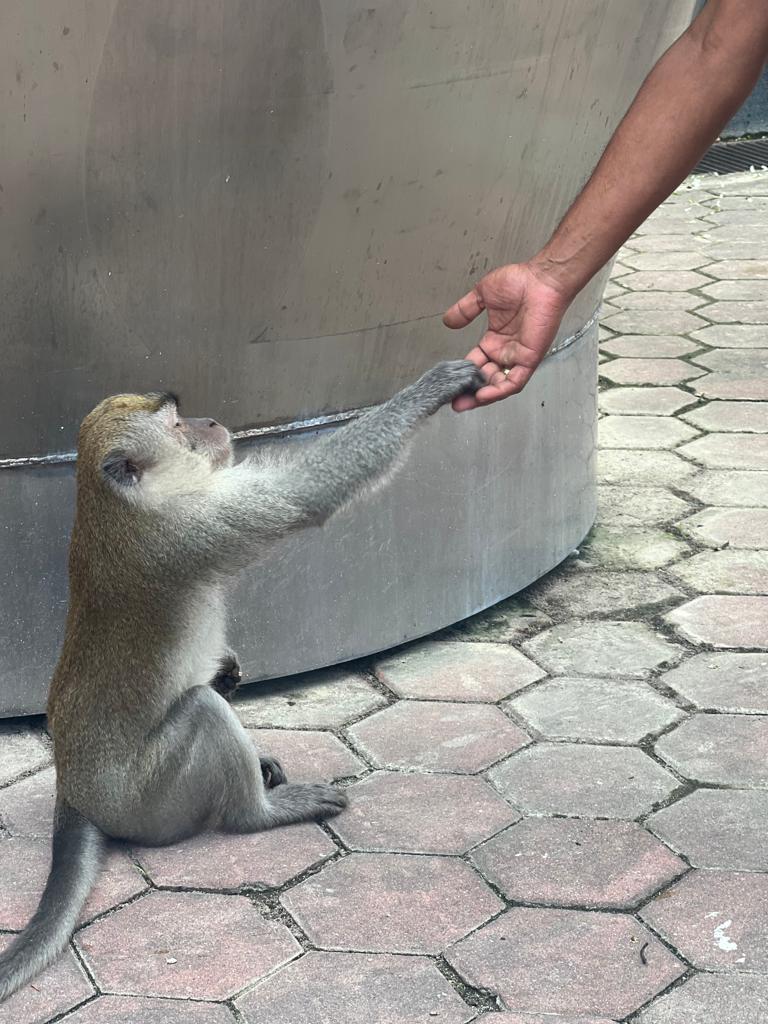Macaques in the midst
6 min read
The monkeys are being traded for the purpose of biomedical research which has especially increased since the Covid-19 pandemic, according to the Born Free organisation.
In Kuala Lumpur, the macaques are seen as pests. I would compare them to our British seagulls who steal your chips at the beach or foxes who rip into bins. Except the macaques are not afraid of the presence of humans – in tourist areas especially.
The purpose of this project and the reason for our visit was to understand and research the on-going conflict that exists between the macaques and humans. Tourists and short term visitors tend to visit KL and see the cute and entertaining side to the monkeys without understanding or acknowledging the reality of the problem that exists.
Malnourished
However, the group from the University of Surrey and I, spent our month-long trip in Malaysia to gain a multifaceted insight into the conflict. We worked in partnership with a local NGO called the Animal Neighbours Project (ANP).
ANP seeks to use research and education to mitigate human wildlife conflict in urban areas. They establish community driven solutions and raise awareness for safe human-animal interactions. To be able to develop a well rounded and thorough understanding of the human-macaque conflict it was essential to understand all members of the community.
In the past thirty years forest land in Malaysia has been reduced by 20 per cent, alongside the reduction in biodiversity, this also means that the macaque population increased in urban areas along with its expansion.
The availability of food is the main driving force that keeps the macaques present in urban areas. They can obtain food through a series of unnatural ways: from opening bins, going into people’s houses and stealing food, and finally simply being handed to them in predominantly tourist areas.
Unnaturally high calorie diets lead to increased reproduction, explaining why Kuala Lumpur has an abnormally high macaque population. Yet the monkeys still remain malnourished due to inappropriate feeding.
GDP
In Kuala Lumpur you can have amazing experiences as a tourist such as going on a firefly boat trip or rowing to see the bioluminescent algae. Amongst those activities being advertised is monkey feeding. One place where monkey feeding is highly advertised is the Batu caves. They are a collection of three caves and Hindu shrines at the top of 272 colourful steps. There are Hindu temples below the steps and monkeys wherever you go. There are markets selling crisps and advertising them as monkey feed.

There are people below the steps playing with the macaques for entertainment and payment, charging people to watch them feed the monkeys. The macaques here are adapted to behave around humans, they will often come up close and if you have any food on you they will climb and take it.
The diet of a macaque usually consists of fruits, leaves, flowers, invertebrates and small animals, according to the National Institute of Health. So feeding at tourist sites can lead to an abnormally high calorie diet and increase macaque population in urban areas. It also encourages them to stay within the area.
But they bring in money from tourists. Tourism in Malaysia is a major contributor to the country’s economy. According to Xinhua, tourism accounted for fourteen percent of Malaysia’s GDP in 2022, even after the global pandemic.
Sacred
What’s more, Hindus associate the macaques with Hanuman. Hanuman is the god of the monkeys and so they enjoy the macaques being present in and around the temples and see them as sacred.
So the monkeys are cute and sacred. They bring in money. What’s the problem? Aside from the wellbeing of the macaques being disrupted by humans, locals in Malaysia often find them annoying and disruptive.
Another way in which macaques get their food is through indirect feeding. They go into bins and eat litter left by humans. A local resident of the rural neighbourhood Bukit Gasing, Mr Visva, explained that they go into people’s houses and take food, which can be quite alarming and unsettling. He explained that young children tend to be afraid of the macaques.
Visva told The Ecologist: “Some people find it a positive thing to feed the animals because the animal is hungry – so ‘I want to feed it’. Whether it is right or wrong is a different thing. So once you start giving them food they become braver. When another resident doesn’t give food they become more aggressive.”
The macaques cause economic losses and damage to residential areas. Visva recalls how they walk along the fibre optic lines, damaging them. They also damage cars and the roofs of houses by climbing on them.
Uproots
Shop owners face a constant battle with the monkeys who steal their products. One shop at Kanching ecoforest used a slingshot with pebbles as ammunition to deter the macaques away because people often find bars and cages as ineffective ways to keep them away. The livelihoods of farmers are also affected when the macaques damage their land.
There is a three step process that the Kuala Lumpur local authorities follow to try and manage the presence of the macaques. The first is to capture them and relocate them further into the forest. The cages however invoke controversy and often are ineffective.

The second step is to fire a warning shot to scare away the monkeys and encourage them to move further back into the forest and away from urban areas. Enkick Saiful, a local council member, explains that their “aim is to set a boundary between humans and wildlife”.
If the first two steps fail to work and the council still receives complaints, the last resort is to shoot the alpha male, which causes the troop to disperse. However, this uproots the foundations of the troop, causing unpredictable behaviour, aggression and worsening the reputation of the macaques.
The Animal Neighbours Project works to raise awareness and use strategies to mitigate the expansion of macaques into urban areas. They aim to educate the people on how to behave around the macaques so that the humans and animals can live together peacefully.
Entitled
One way in which they do this is by educating their audiences on how to read macaque facial expressions. The fear grin means the monkey is scared and the human should look away.
Lip smacking is a friendly signal that the monkeys do to each other, if a human did it back to the monkey the mother may detect that as a threat and become aggressive.Raised eyebrows are a warning sign that the human should retreat and avoid eye contact. A sleepy yawn indicates aggression. ANP also works with local organisations to create substantial and sustainable bin latches or bungee cords to stop the macaques from getting into the bins in hope that if they cannot get food, they will retreat into the forests.
Encik Saiful also told me that their efforts to solve this conflict is “not to manage the wildlife but to manage the people”. This is a significant sentiment that I took away from the trip. The reason that the macaques have become a problem is because we, humans, took away their natural habitat.
It is important to remember and recognise that the animals are entitled to the space that they occupy. The message that ANP puts across is a good reminder that our way of living needs to be evaluated and adapted, rather than the macaques’.
This Author
Ruby Harbour is a freelance journalist.





